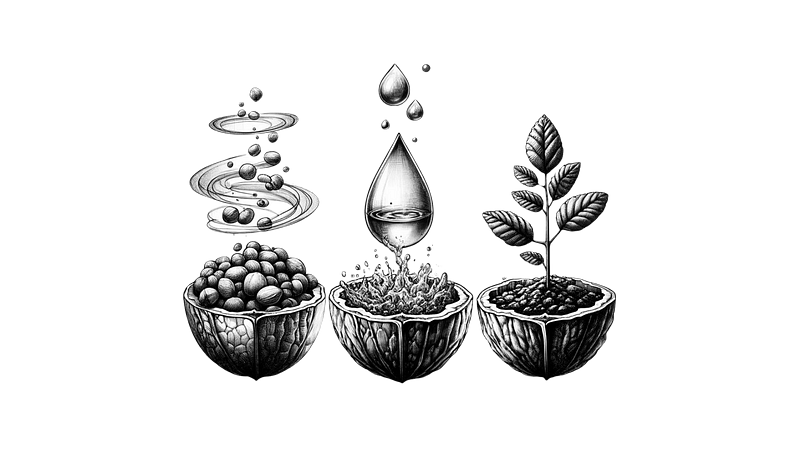Innovative Uses of Nut Shells for Environmental Cleanup
Written on
Chapter 1: Introduction to Nut Shells in Pollution Control
Nut shells, such as those from pistachios, walnuts, coconuts, and peanuts, have attracted attention as affordable and efficient materials for absorbing pollutants from various environments, including water, soil, and air. Their high surface area and porous nature render them particularly adept at capturing a wide range of contaminants, including heavy metals, dyes, and organic substances. This natural application is crucial for environmental sustainability and pollution management. Below is a concise overview of scientific studies focused on the use of nut shells as adsorbents in pollution control:

A symbolic representation featuring three oversized nut shells, illustrating their capabilities in air purification, water treatment, and soil enhancement.
Section 1.1: Heavy Metal Removal
Research has examined the ability of nut shells to extract heavy metals such as lead, cadmium, and chromium from contaminated water. The adsorption process involves these metal ions binding to the surfaces of the nut shell materials. A study by Sattar (2020) demonstrated the effectiveness of a unique hybrid biosorbent made from almond shells and the mushroom Pleurotus sajor-caju in removing nickel and lead from wastewater.
Section 1.2: Dye Adsorption
Nut shells have also proven effective in adsorbing industrial dyes, a prevalent pollutant in textile and dye industries. The work of Thomas and Thalla (2022) highlights this potential, showing that nutmeg seed shell biochar serves as an effective adsorbent for removing synthetic dyes from wastewater.
Reference: Teema Thomas & Arun Kumar Thalla (2022). Nutmeg seed shell biochar as an effective adsorbent for removal of remazol brilliant blue reactive dye: kinetic, isotherm, and thermodynamic study. Energy Sources, Part A: Recovery, Utilization, and Environmental Effects, 44:1, 893–911. DOI: 10.1080/15567036.2022.2050850
Subsection 1.2.1: Organic Pollutant Adsorption
Nut shells have shown promise in capturing organic pollutants such as phenols, pesticides, and pharmaceuticals from water sources. Their carbon-based structure and functional groups facilitate interactions with various organic compounds, as noted by Kamal et al. (2020), which supports the use of nut shell materials for effective water treatment.
Section 1.3: Modification for Enhanced Performance
Nut shell adsorbents can be enhanced through chemical or physical modifications to boost their adsorption capacity and specificity for certain pollutants. Techniques such as activation using acids or bases, and physical methods involving steam or CO2, can expand their porosity and surface area. El Khomri et al. (2021) explored the regeneration of argan nutshells and almond shells using nitric acid, demonstrating their efficacy in removing cationic dyes from solutions.
Reference: El Khomri, Mohammed et al. (2021). Regeneration of argan nutshell and almond shell using HNO3 for their reusability to remove cationic dye from aqueous solution. Chemical Engineering Communications, 209, 1–12. DOI: 10.1080/00986445.2021.1963960
Chapter 2: Sustainability and Future Directions
Utilizing nut shells as adsorbents aligns with sustainable practices and waste valorization—transforming agricultural byproducts into valuable resources. For instance, a study by Das, Bar, and Das (2020) effectively removed lead ions from water using walnut and almond nutshells, showcasing their potential as green adsorbents.
Research Challenges and Opportunities
Despite the evident benefits of nut shells as adsorbents, challenges remain, including the regeneration of spent shells, proper disposal methods, and accurately measuring adsorption efficiency for various pollutants. While current knowledge is somewhat limited, ongoing research will be essential to fully understand the implications of nut shells on health, the environment, and related fields over time.
Environmental Futurism
Looking ahead, future studies should focus on enhancing the regeneration and reusability of used nut shells. Developing scalable and cost-effective methodologies for harnessing these materials for pollution control is paramount. Evaluating the feasibility of large-scale nut shell production and management across different regions will also be crucial in determining their overall effectiveness.
The exploration of nut shells as a means of mitigating pollution opens up exciting possibilities for innovation inspired by nature. If these natural materials can significantly reduce pollutants, one can only imagine the creative solutions that the environment may inspire in the future.
Thank you for your interest in my work!
The first video titled "The Shell Nuts - Episode 12 - Shell Cleaning, Restoration, and Protection" provides insights into the processes involved in cleaning and restoring nut shells for various applications.
The second video, "How Olive Stones & Walnut Shells Can Change the Energy Game: Waste to Wonder for a Sustainable World," discusses innovative ways to repurpose waste materials for sustainability.